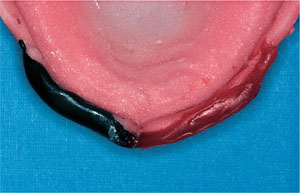Chapter 9
Building On Success with Copy Dentures
Aim
The aim of this chapter is to discuss the use of the replica or copy denture technique.
Outcome
The polished surfaces of complete dentures can be harnessed to facilitate physiological retention. The clinician should understand the indications for the use of the copy technique and realise its limitations.
Introduction
The issue of patient adaptation to complete replacement dentures has been discussed in Chapter 1. In general, the ability to adapt to change diminishes with age. A key element identified in helping the patient to adapt is the shape of the polished surface of the denture. If the patient has had a set of complete dentures for many years, then they will probably have used their ability to control the dentures with their orofacial musculature to overcome loss of adaptation to the tissues. If the clinician substantially changes the shape of the polished surface, then the patient may not be able to control the new dentures. For this reason, the clinician should duplicate the shape of the old dentures where possible. One technique employed for achieving this is the “copy technique”.
Copy Technique – Rationale
The purpose of the copy technique is to reproduce as closely as possible the polished surface shape of the old dentures in the new dentures. The principal changes in the new denture will be to the impression surface and occlusal surfaces. The technique involves recording an impression of the denture which is then used to produce a replica or template. The replica is then used in the clinical and laboratory stages of replacement denture construction.
Procedure
The stages involved in the construction of copy dentures are as follows:
-
Record impressions of the dentures using one of the techniques described below. The technician uses these to produce the replicas.
-
Provide an intercuspal record to help the technician mount the replicas on an articulator.
-
Select a shade of tooth. The technician should be instructed to copy the mould of the previous teeth, but a specific instruction regarding the mould can also be provided.
-
Upon return of the replicas, they should be checked for balanced occlusion and articulation. Advise the patient that the replicas will be loose at this stage. If they are incorrect, then modifications should be made at the chairside, or by re-registering the jaw relationship and asking the technician to reset the teeth at the new centric relation record. The appearance of the teeth should be checked.
-
If the patient is happy with the trial dentures, then definitive impressions of the denture-bearing area should be recorded using a closed-mouth impression technique.
-
Check that the impressions are adequate. On the impression for the maxillary denture, indicate the position of the postdam to the technician using an indelible pencil.
-
The dentures are then processed and returned to the clinician for delivery to the patient.
-
The patient should be given the usual post-insertion instructions after checking and delivery of the dentures.
Recording the impressions of the dentures
Prior to recording the impressions of the denture, areas of gross underextension should be rectified with green stick tracing compound (Fig 9-1). This can also be undertaken at the trial denture stage, but it may be difficult to get green stick tracing compound to adhere to the replicas.

Fig 9-1 Correction of the peripheral extension prior to making the copy box impression. As shown, this can be achieved using beading wax or green stick tracing compound. (Courtesy of Mr ID Murray)
Various techniques have been described for recording the impression of the dentures. The soap box technique involves using a plastic soap box with an area cut out for sprues (Fig 9-2). The denture is placed (occlusal surface downwards) into one half of the box which has been filled with alginate (irreversible hydrocolloid). Sprues should be placed adjacent to the posterior border of the denture, and green stick tracing compound is a suitable material for this purpose. Once this material has set, excess material should be trimmed back to the edge of the box and petroleum jelly applied to the alginate. The other half of the soap box shoul/>
Stay updated, free dental videos. Join our Telegram channel

VIDEdental - Online dental courses


